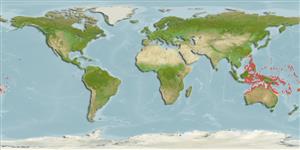Common names from other countries
>
Eupercaria/misc (Various families in series Eupercaria) >
Nemipteridae (Threadfin breams, Whiptail breams)
Etymology: Scolopsis: Name from the Greek masculine noun 'skolos' meaning 'thorn' and suffix '-opsis' (from Greek feminine n. 'opsis' meaning 'aspect', 'appearance') meaning ‘thorny appearance’ presumably referring to 'les dentelures de la préopercule, en ont aussi, et même d'épineuses, aux sous-orbitaires' mentioned by Cuvier (1814) in his designation of the genus. Name ending in -'opsis' are treated as feminine according to ICZN 1999: Article 30.1.2 (Ref. 130620).
More on author: Kner.
Environment: milieu / climate zone / depth range / distribution range
Ecologie
marien rifbewoner; diepte 1 - 20 m (Ref. 9785). Tropical; 24°N - 25°S, 113°E - 167°W (Ref. 3810)
Western Pacific: South China Sea to Samoa, north to the Philippines, south to Scott Reef, New Caledonia and Tonga (Ref. 37816).
Grootte / Gewicht / Leeftijd
Maturity: Lm ? range ? - ? cm
Max length : 25.0 cm TL mannelijk / geslacht onbekend; (Ref. 90102); common length : 14.0 cm SL mannelijk / geslacht onbekend; (Ref. 3810)
Dorsale stekels (totaal) : 10; Dorsale zachte stralen (totaal) : 9; Anale stekels: 3; Anale zachte stralen: 7. Head scales reaching forward to level of middle of eyes. Lower limb of preopercle naked. Antrorse (forward-directed) suborbital spine absent. Pelvic fins long, reaching to or just beyond level of anus. Axillary scale present. Color: Upper body dusky grey or brown, silvery-white below. Scales on sides with pearly-blue centers. 3 bluish-white stripes on snout.
Inhabits sandy bottoms in lagoons and areas close to reefs and mangroves. Occurs singly or in small aggregations (Ref. 9785).
Levenscyclus en paargedrag
Maturities | Voortplanting | Spawnings | Egg(s) | Fecundities | Larven
Russell, B.C., 1990. FAO Species Catalogue. Vol. 12. Nemipterid fishes of the world. (Threadfin breams, whiptail breams, monocle breams, dwarf monocle breams, and coral breams). Family Nemipteridae. An annotated and illustrated catalogue of nemipterid species known to date. FAO Fish. Synop. 125(12):149p. Rome: FAO. (Ref. 3810)
Status op de Rode Lijst van het IUCN (Ref. 130435)
CITES (Ref. 128078)
Not Evaluated
Gevaar voor de mens
Harmless
Gebruik door de mens
Visserij: visserij voor eigen gebruik
Tools
Speciale rapporten
Download XML
Internetbronnen
Estimates based on models
Preferred temperature (Ref.
115969): 26.5 - 29.3, mean 28.6 (based on 1681 cells).
Fylogenetische diversiteitsindex (Ref.
82804): PD
50 = 0.5000 [Uniqueness, from 0.5 = low to 2.0 = high].
Bayesian length-weight: a=0.01622 (0.00730 - 0.03605), b=2.98 (2.80 - 3.16), in cm Total Length, based on LWR estimates for this Genus-body shape (Ref.
93245).
Trofisch niveau (Ref.
69278): 3.6 ±0.5 se; based on size and trophs of closest relatives
Weerstandsvermogen (Ref.
120179): Hoog, minimale populatieverdubbelingstijd minder dan 15 maanden (Preliminary K or Fecundity.).
Fishing Vulnerability (Ref.
59153): Low vulnerability (15 of 100).
